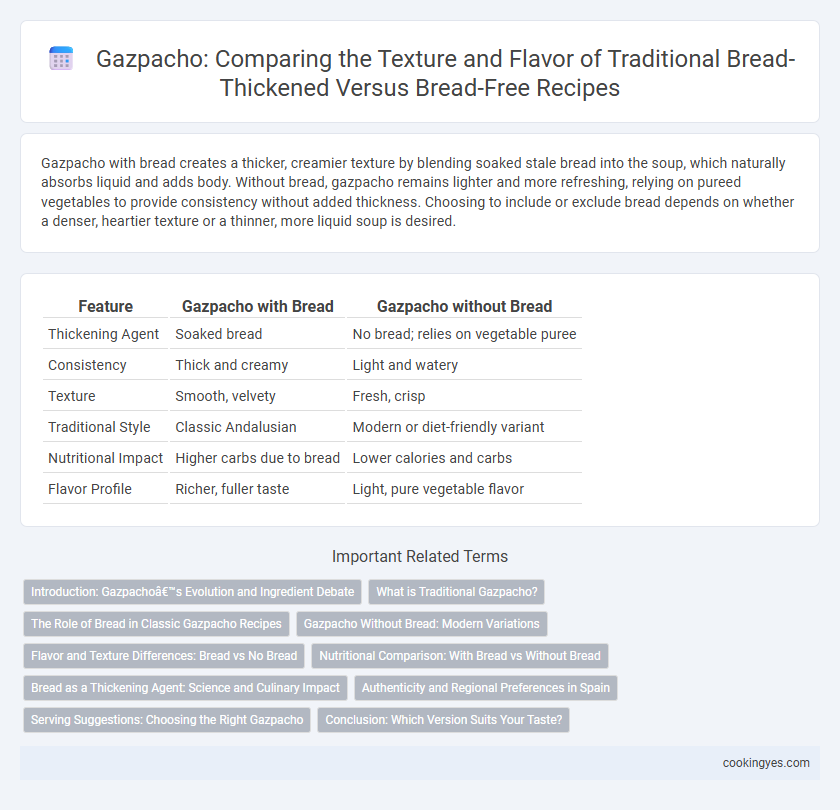Gazpacho with bread creates a thicker, creamier texture by blending soaked stale bread into the soup, which naturally absorbs liquid and adds body. Without bread, gazpacho remains lighter and more refreshing, relying on pureed vegetables to provide consistency without added thickness. Choosing to include or exclude bread depends on whether a denser, heartier texture or a thinner, more liquid soup is desired.
Table of Comparison
| Feature | Gazpacho with Bread | Gazpacho without Bread |
|---|---|---|
| Thickening Agent | Soaked bread | No bread; relies on vegetable puree |
| Consistency | Thick and creamy | Light and watery |
| Texture | Smooth, velvety | Fresh, crisp |
| Traditional Style | Classic Andalusian | Modern or diet-friendly variant |
| Nutritional Impact | Higher carbs due to bread | Lower calories and carbs |
| Flavor Profile | Richer, fuller taste | Light, pure vegetable flavor |
Introduction: Gazpacho’s Evolution and Ingredient Debate
Gazpacho, a traditional Spanish cold soup, has evolved from simple crushed vegetables to include various thickening methods, with bread being a classic ingredient that enhances texture and flavor. Using bread in gazpacho adds body and creaminess without dairy, while breadless versions rely on pureed vegetables and sometimes nuts or seeds for a lighter, more refreshing consistency. The debate between gazpacho with or without bread centers on maintaining authenticity versus adapting for gluten-free or lighter dietary preferences.
What is Traditional Gazpacho?
Traditional gazpacho is a cold Spanish soup originating from Andalusia, typically thickened with stale bread soaked in water to achieve a rich, velvety texture. Using bread as a thickening agent enhances the soup's body and adds a subtle depth of flavor, maintaining the authentic rustic character. Gazpacho without bread offers a lighter, fresher consistency, highlighting the pure tastes of ripe tomatoes, cucumbers, and peppers without the absorptive quality of bread.
The Role of Bread in Classic Gazpacho Recipes
Bread plays a crucial role in classic gazpacho recipes by providing natural thickness and a smooth, creamy texture without the need for artificial thickeners. Traditional Andalusian gazpacho incorporates stale bread soaked in the mixture, which absorbs the liquid and binds ingredients together, enhancing the soup's body and mouthfeel. Conversely, gazpacho without bread results in a lighter, more refreshing soup, but misses the classic rich consistency that bread imparts.
Gazpacho Without Bread: Modern Variations
Gazpacho without bread emphasizes a lighter, fresher texture by relying on ingredients like cucumbers, tomatoes, and bell peppers to achieve natural thickness. Modern variations often incorporate avocado, yogurt, or nuts as alternative thickeners, enhancing creaminess without gluten. This breadless approach caters to gluten-free diets and highlights the vibrant flavors of raw vegetables for a refreshing cold soup experience.
Flavor and Texture Differences: Bread vs No Bread
Gazpacho with bread offers a richer, creamier texture due to the bread's ability to absorb and thicken the soup, enhancing its body and providing a subtle, doughy flavor that balances the acidity of tomatoes and vinegar. In contrast, gazpacho without bread maintains a lighter, more refreshing consistency with a cleaner, sharper taste, allowing the fresh vegetable flavors like cucumber, bell pepper, and garlic to stand out more distinctly. The presence of bread also slightly mutes the soup's bright, tangy notes, creating a smoother, more harmonious flavor profile compared to the crisp, vibrant character of breadless gazpacho.
Nutritional Comparison: With Bread vs Without Bread
Gazpacho with bread contains higher carbohydrates and dietary fiber, contributing to increased caloric content and a thicker texture. In contrast, gazpacho without bread offers a lighter option with lower calories and reduced carbohydrates, suitable for low-carb or gluten-free diets. Both variations maintain rich vitamin C and antioxidant levels from fresh vegetables, but the inclusion of bread notably alters the macronutrient profile.
Bread as a Thickening Agent: Science and Culinary Impact
Bread as a thickening agent in gazpacho leverages starch gelatinization, which absorbs liquid and creates a smooth, creamy texture without relying on added fats. The porous structure of stale bread breaks down during blending, contributing natural viscosity and body that enhance mouthfeel while preserving the chilled freshness of traditional gazpacho. Using bread not only thickens but also imparts subtle flavor complexity through fermentation byproducts, distinguishing it from gazpacho variants that rely solely on pureed vegetables or emulsifiers.
Authenticity and Regional Preferences in Spain
Gazpacho with bread, traditionally known as Salmorejo in Andalusia, offers a thicker, creamier texture reflecting authentic regional preference, as bread acts as a natural thickening agent. In contrast, gazpacho without bread, common in regions like Murcia, emphasizes a lighter, fresher consistency that aligns with local tastes favoring pure vegetable flavors over added starch. The choice between these variations highlights Spain's diverse culinary heritage and the importance of bread in maintaining authentic gazpacho thickness and flavor profiles.
Serving Suggestions: Choosing the Right Gazpacho
Gazpacho with bread offers a thicker, creamier texture ideal for hearty servings and pairs well with rustic toppings like diced vegetables or cured meats. Gazpacho without bread maintains a lighter, more refreshing profile, perfect for hot weather and garnished with fresh herbs or a drizzle of olive oil. Selecting the right gazpacho depends on desired consistency and complementary accompaniments, ensuring the dish suits the occasion and enhances flavor balance.
Conclusion: Which Version Suits Your Taste?
Gazpacho with bread offers a creamier, thicker texture due to the soaked bread that enhances flavor and adds body, ideal for those seeking a richer experience. Gazpacho without bread maintains a lighter, fresher consistency with a more intense vegetable taste, suitable for a low-carb or lighter option. Choosing between the two depends on personal preference for either a traditional, hearty gazpacho or a crisp, refreshing version.
Gazpacho with Bread vs Gazpacho without Bread for Thickening Infographic

 cookingyes.com
cookingyes.com